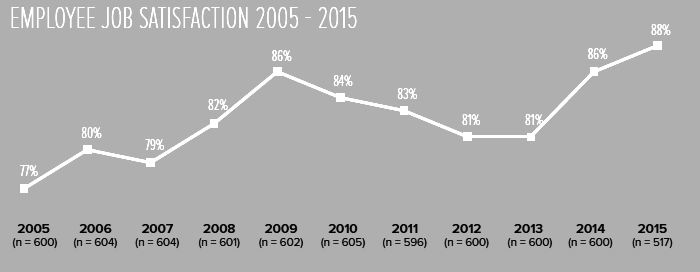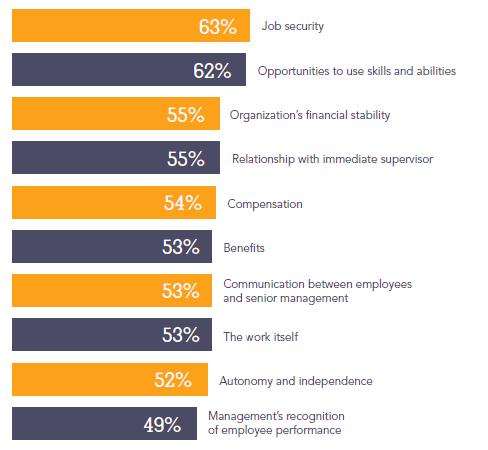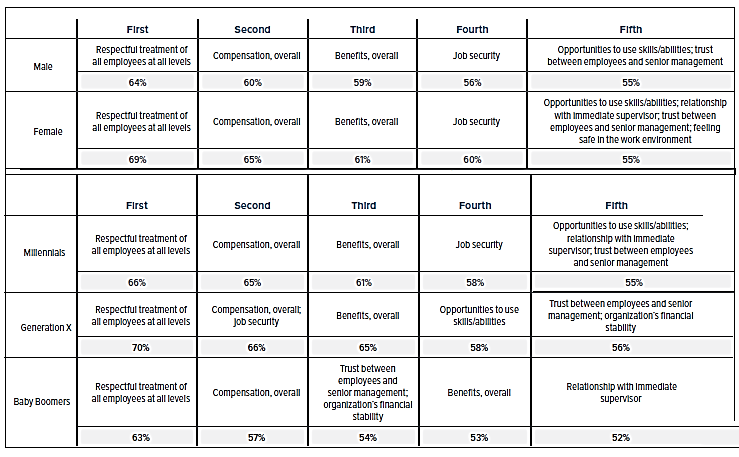Introduction
Managers often focus on creating high-performance work environments that can motivate employees, promote their involvement in decision-making, and stimulate them to achieve higher performance results (Giannikis & Nikandrou 2013). High-performance environments are specific settings and conditions with the help of which employers stimulate workers to improve their performance and productivity. In many cases, employers are interested in creating such environments despite using a lot of resources because they gain significant benefits: higher productivity, improved quality, higher revenues, and commitment (Ugheoke et al. 2015). Still, the problem is that orienting to significant achievements and applying additional resources to motivate employees, leaders cannot guarantee staff’s positive reactions because high-performance environments can be viewed as challenging for those employees whose level of commitment is low or who are not ready to improve their performance (Weinberg et al. 2013). Therefore, the key research question that needs to be addressed is how high-performance work environments can influence employee satisfaction and organizational culture. The purpose of this paper is to describe possible correlations between high-performance environments, employee satisfaction, and organizational culture in the sphere of business.
Literature Review
The theoretical framework of this research is grounded in the resource-based view (RBV) in management. According to the RBV, employees are discussed as resources that can contribute to increasing productivity and gaining revenues. To address employees as valuable and inimitable resources, managers also use other types of resources, including competitive payments or positive working environments (Pichler et al. 2014). Therefore, according to the RBV, when managers create high-performance environments, they aim at utilizing the potential of their employees while stimulating their job satisfaction (Agbozo et al. 2017). In addition to the theoretical framework, the conceptual framework of this research is based on the discussion of such concepts as work environments, high-performance environments, employee satisfaction, and organizational culture.
Work environments include such aspects as job responsibilities and a specific context. According to Raziq and Maulabakhsh (2015), in most cases, leaders and human resource managers can modify contexts in order to make employees work effectively even when having many job responsibilities or when performing challenging tasks. These modifications can be associated with providing training, feedback, rewards, and opportunities for empowerment (Akhter et al. 2016). However, Fabi, Lacoursière, and Raymond (2015) note that positive and employee-oriented environments are not high-performance work environments because these specific contexts are characterized by sharing values and goals, participation of employees in decision-making processes, extrinsic and intrinsic motivation of employees, flexibility, the safety of environments, teamwork, and cooperation. As a result, employers receive significant contributions from their employees whose motivation, creativity, commitment, productivity, and performance increase. However, there are also managers who are not aware of the importance of specific working environments for employees, their commitment, and satisfaction (Agbozo et al. 2017). Thus, employee satisfaction should be taken into account when organizations want to improve performance and receive higher revenues.
Employee satisfaction is defined as a worker’s specific emotional state associated with his or her positive attitudes toward job responsibilities and an organization (Chowhan, Zeytinoglu & Cooke 2016). While focusing on employee satisfaction, researchers claim that it can be stimulated when employers provide high rewards and bonuses, guarantee job security, provide opportunities for training and development, as well as opportunities for promotion (Agbozo et al. 2017). Furthermore, these activities also contribute to developing an effective organizational culture that can be related to following certain rules and norms, orienting to high performance, avoiding absenteeism, and promoting retention (Samuel 2015). As a result, the developed organizational culture in a company is one of the factors that lead to sustaining the competitive advantage.
There are many studies in which relationships between high-performance work environments or systems and employee satisfaction or organizational culture were examined. Fabi, Lacoursière, and Raymond (2015) note that there is a positive correlation between developing high-performance environments with the help of applying high-performance systems and employees’ satisfaction. Agbozo et al. (2017) also argue that the implementation of high-performance systems leads to improving the organizational culture because employees become not only satisfied with their role and position in a company: their commitment increases, and the focus on corporate values improves. However, Yanadori and Jaarsveld (2014) claim that the impact of high-performance environments on employees and their satisfaction, as well as on an overall situation in organizations and their culture, is not always positive. Thus, promoting employees’ empowerment, involvement, creativity, and cooperation, employers create environments in which employees are expected to demonstrate the best results, stress levels can increase, and job satisfaction can decrease because of intense pressure levels (Rabl et al. 2014). Still, this situation can be avoided if employers create employee-oriented high-performance environments where the main focus is on flexibility, motivation, cooperation, support, and work-life balance.
Methodology
The quantitative methodology was selected for this research to examine the possible impact of high-performance work environments and associated practices on employee satisfaction and organizational culture. The descriptive study and analysis were used for this research to refer to the evidence of this problem. Statistical data and graphs retrieved from the report by the Society for Human Resource Management (2016) and the whitepaper by ADP Canada (2015) are related to management tendencies in the United States and Canada. To answer the research question formulated for this paper, it was important to collect statistical and descriptive numerical data on employee job satisfaction trends for the United States in 2005-2015, work environments associated with job satisfaction and effective organizational culture, and differences in job satisfaction contributors associated with high-performance environments for genders and generations. The descriptive analysis of this information is critical to conclude on the impact that high-performance work environments and related practices can have on employees’ job satisfaction and culture in organizations.
Data Analysis and Findings
To draw conclusions regarding the impact of high-performance work environments on culture and employee satisfaction, the data that represent contributors and factors associated with specific work environments and their influence on employees’ perception of job satisfaction were selected. These contributors are also related to changes in the organizational culture. Figure 1 represents changes in employee job satisfaction for 2005-2015 according to the studies conducted by the Society for Human Resource Management (2016).

As it is shown in Figure 1, positive trends in employee satisfaction were observed during the period of 2005-2015. In 2005, 77% of employees reported that they were satisfied with their work conditions and environments, as well as other job-related factors. In 2015, the situation improved significantly in comparison to the data for 2005, and 88% of employees reported being satisfied with their jobs and environments (Society for Human Resource Management 2016). These data indicate that the situation improved by 11% over ten years. Figure 2 presents data regarding specific factors or characteristics of high-performance work environments and the developed organizational culture that can influence increases in employees’ satisfaction.

It is found that such characteristics of high-performance work environments as job security and opportunities to use professional skills and abilities influence job satisfaction of 63% and 62% of respondents accordingly. Communication with managers and motivation are important for 53% of employees. However, actively promoted autonomy and independence of employees in decision-making, as well as the recognition of their performance, affect job satisfaction of only 52% and 49% of employees accordingly. Table 1 represents differences in job satisfaction contributors depending on gender and age (generations).

(Society for Human Resource Management 2016, p. 52).
As it is shown in Table 1, job satisfaction of 64% of males and 69% of females increases in association with the respectful treatment provided by managers and leaders. This factor is also important for all generations, including Baby Boomers, Generation X, and Millennials. The second important factor of work environments that contributes to job satisfaction is compensation that is equally critical for both genders and all generations. Job security is identified as important for males, females, and Millennials. Opportunities to use skills and trusting relationships with managers are important for 55% of males and females. These results indicate that key features of high-performance work environments, for example, empowerment, the realization of potential and skills, job security, and competitive compensation among others, are associated with high levels of job satisfaction in employees.
Discussion
The focus on creating high-performance work environments is observed during the last two decades, and many researchers view them as leading to the development of an effective organizational culture and higher job satisfaction (Giannikis & Nikandrou 2013). According to the analyzed data, increases in job satisfaction observed in 2015 in comparison to 2005 can be explained with reference to the fact that today high-performance work environments are organized in many companies to improve productivity and organizational culture. These findings are also in line with study results by Rabl et al. (2014) and Yanadori and Jaarsveld (2014) who note that today high-performance work systems are applied in many successful organizations.
Key features of high-performance environments are flexibility, security, sharing of values and goals, empowerment, autonomy, independence, motivation, developed communication with managers and supervisors, creativity, participation of employees in decision making, teamwork, cooperation, and competitive compensation (Giannikis & Nikandrou 2013). Data analysis indicates that employees positively assess such environments because these features are discussed as contributors to their job satisfaction, among which job security and opportunities to use professional skills and abilities are discussed as directly correlated with job satisfaction. In their study, Fabi, Lacoursière, and Raymond (2015) also claim that employees’ satisfaction increases depending on their feeling of security, support, and empowerment in an organization. Thus, it is possible to state that certain factors associated with high-performance work environments can positively affect employees’ satisfaction, as well as the created culture in an organization.
The analysis of findings also indicates that males and females, who belong to different generations, are inclined to prioritize the respectful treatment of employees as a key contributor to their job satisfaction. This aspect is explained with reference to Bakotić (2016) who states that respecting employees, managers and leaders often provide them with higher autonomy and empowerment that potentially lead to employees’ satisfaction and commitment. Although risks of intense pressure and stress are high in high-performance environments, as it is noted by Ugheoke et al. (2015), the respect for employees and their needs addresses this problem, contributing to their satisfaction.
Conclusion
The collected and analyzed data indicate that there are positive correlations between high-performance work environments, their features, and employee satisfaction, as well as the organizational culture created as a result of developing these environments. Therefore, it is possible to state that high-performance environments can significantly influence employee satisfaction and organizational culture. This impact can be viewed as positive. In spite of the fact that some researchers state that high-performance work environments are often challenging for employees, the data demonstrate that the majority of female and male employees, who work in US and Canadian organizations, choose characteristics associated with high-performance environments as positively influencing their job satisfaction.
Reference List
ADP Canada 2015, Employee satisfaction vs. employee engagement: are they the same thing?. Web.
Agbozo, GK, Owusu, IS, Hoedoafia, MA & Atakorah, YB 2017, ‘The effect of work environment on job satisfaction: evidence from the banking sector in Ghana’, Journal of Human Resource Management, vol. 5, no. 1, pp. 12-18.
Akhter, N, Raza, H, Ashraf, A, Ahmad, A & Aslam, N 2016, ‘Impact of training and development, performance appraisal and reward system on job satisfaction’, International Review of Management and Business Research, vol. 5, no. 2, pp. 561-572.
Bakotić, D 2016, ‘Relationship between job satisfaction and organizational performance’, Economic Research, vol. 29, no. 1, pp. 118-130.
Chowhan, J, Zeytinoglu, IU & Cooke, GB 2016, ‘Immigrants and job satisfaction: do high-performance work systems play a role?’, Economic and Industrial Democracy, vol. 37, no. 4, pp. 690-715.
Fabi, B, Lacoursière, R & Raymond, L 2015, ‘Impact of high-performance work systems on job satisfaction, organizational commitment, and intention to quit in Canadian organizations’, International Journal of Manpower, vol. 36, no. 5, pp. 772-790.
Giannikis, S & Nikandrou, I 2013, ‘The impact of corporate entrepreneurship and high-performance work systems on employees’ job attitudes: empirical evidence from Greece during the economic downturn’, The International Journal of Human Resource Management, vol. 24, no. 19, pp. 3644-3666.
Pichler, S, Varma, A, Yu, A, Beenen, G & Davoudpour, S 2014, ‘High-performance work systems, cultures and gender demography’, Employee Relations, vol. 36, no. 6, pp. 693-707.
Rabl, T, Jayasinghe, M, Gerhart, B & Kühlmann, TM 2014, ‘A meta-analysis of country differences in the high-performance work system–business performance relationship: the roles of national culture and managerial discretion’, Journal of Applied Psychology, vol. 99, no. 6, pp. 1011-1021.
Raziq, A & Maulabakhsh, R 2015, ‘Impact of working environment on job satisfaction’, Procedia Economics and Finance, vol. 23, no. 1, pp. 717-725.
Samuel, OB 2015, ‘The effects of organizational culture and stress on organizational employee commitment’, Management, vol. 5, no. 3, pp. 96-106.
Society for Human Resource Management 2016, Employee job satisfaction and engagement: revitalizing a changing workforce. Web.
Ugheoke, SO, Al-Rawas, N, Isa, M & Noor, W 2015, ‘Implementation of high-performance work system in public organizations: implication to organizational performance’, Asian Social Science, vol. 11, no. 28, pp. 139-148.
Weinberg, DB, Avgar, AC, Sugrue, NM & Cooney‐Miner, D 2013, ‘The importance of a high‐performance work environment in hospitals’, Health Services Research, vol. 48, no. 1, pp. 319-332.
Yanadori, Y & Jaarsveld, D 2014, ‘The relationships of informal high-performance work practices to job satisfaction and workplace profitability’, Industrial Relations: A Journal of Economy and Society, vol. 53, no. 3, pp. 501-534.